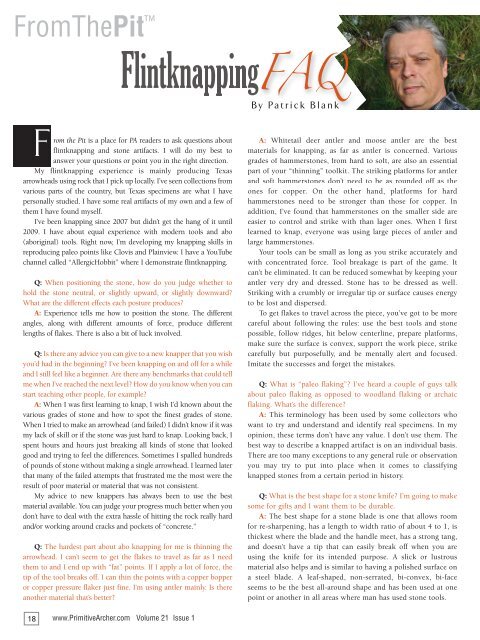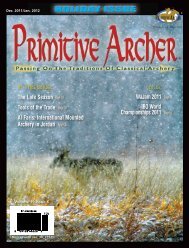In This Issue: plus: - Primitive Archer Online
In This Issue: plus: - Primitive Archer Online
In This Issue: plus: - Primitive Archer Online
Create successful ePaper yourself
Turn your PDF publications into a flip-book with our unique Google optimized e-Paper software.
FromThePit <br />
From the Pit is a place for PA readers to ask questions about<br />
flintknapping and stone artifacts. I will do my best to<br />
answer your questions or point you in the right direction.<br />
My flintknapping experience is mainly producing Texas<br />
arrowheads using rock that I pick up locally. I’ve seen collections from<br />
various parts of the country, but Texas specimens are what I have<br />
personally studied. I have some real artifacts of my own and a few of<br />
them I have found myself.<br />
I’ve been knapping since 2007 but didn’t get the hang of it until<br />
2009. I have about equal experience with modern tools and abo<br />
(aboriginal) tools. Right now, I’m developing my knapping skills in<br />
reproducing paleo points like Clovis and Plainview. I have a YouTube<br />
channel called “AllergicHobbit” where I demonstrate flintknapping.<br />
Q: When positioning the stone, how do you judge whether to<br />
hold the stone neutral, or slightly upward, or slightly downward?<br />
What are the different effects each posture produces?<br />
A: Experience tells me how to position the stone. The different<br />
angles, along with different amounts of force, produce different<br />
lengths of flakes. There is also a bit of luck involved.<br />
Q: Is there any advice you can give to a new knapper that you wish<br />
you’d had in the beginning? I’ve been knapping on and off for a while<br />
and I still feel like a beginner. Are there any benchmarks that could tell<br />
me when I’ve reached the next level? How do you know when you can<br />
start teaching other people, for example?<br />
A: When I was first learning to knap, I wish I’d known about the<br />
various grades of stone and how to spot the finest grades of stone.<br />
When I tried to make an arrowhead (and failed) I didn’t know if it was<br />
my lack of skill or if the stone was just hard to knap. Looking back, I<br />
spent hours and hours just breaking all kinds of stone that looked<br />
good and trying to feel the differences. Sometimes I spalled hundreds<br />
of pounds of stone without making a single arrowhead. I learned later<br />
that many of the failed attempts that frustrated me the most were the<br />
result of poor material or material that was not consistent.<br />
My advice to new knappers has always been to use the best<br />
material available. You can judge your progress much better when you<br />
don’t have to deal with the extra hassle of hitting the rock really hard<br />
and/or working around cracks and pockets of “concrete.”<br />
Q: The hardest part about abo knapping for me is thinning the<br />
arrowhead. I can’t seem to get the flakes to travel as far as I need<br />
them to and I end up with “fat” points. If I apply a lot of force, the<br />
tip of the tool breaks off. I can thin the points with a copper bopper<br />
or copper pressure flaker just fine. I’m using antler mainly. Is there<br />
another material that’s better?<br />
18<br />
FlintknappingFAQ<br />
B y P a t r i c k B l a n k<br />
www.<strong>Primitive</strong><strong>Archer</strong>.com Volume 21 <strong>Issue</strong> 1<br />
A: Whitetail deer antler and moose antler are the best<br />
materials for knapping, as far as antler is concerned. Various<br />
grades of hammerstones, from hard to soft, are also an essential<br />
part of your “thinning” toolkit. The striking platforms for antler<br />
and soft hammerstones don’t need to be as rounded off as the<br />
ones for copper. On the other hand, platforms for hard<br />
hammerstones need to be stronger than those for copper. <strong>In</strong><br />
addition, I’ve found that hammerstones on the smaller side are<br />
easier to control and strike with than lager ones. When I first<br />
learned to knap, everyone was using large pieces of antler and<br />
large hammerstones.<br />
Your tools can be small as long as you strike accurately and<br />
with concentrated force. Tool breakage is part of the game. It<br />
can’t be eliminated. It can be reduced somewhat by keeping your<br />
antler very dry and dressed. Stone has to be dressed as well.<br />
Striking with a crumbly or irregular tip or surface causes energy<br />
to be lost and dispersed.<br />
To get flakes to travel across the piece, you’ve got to be more<br />
careful about following the rules: use the best tools and stone<br />
possible, follow ridges, hit below centerline, prepare platforms,<br />
make sure the surface is convex, support the work piece, strike<br />
carefully but purposefully, and be mentally alert and focused.<br />
Imitate the successes and forget the mistakes.<br />
Q: What is “paleo flaking”? I’ve heard a couple of guys talk<br />
about paleo flaking as opposed to woodland flaking or archaic<br />
flaking. What’s the difference?<br />
A: <strong>This</strong> terminology has been used by some collectors who<br />
want to try and understand and identify real specimens. <strong>In</strong> my<br />
opinion, these terms don’t have any value. I don’t use them. The<br />
best way to describe a knapped artifact is on an individual basis.<br />
There are too many exceptions to any general rule or observation<br />
you may try to put into place when it comes to classifying<br />
knapped stones from a certain period in history.<br />
Q: What is the best shape for a stone knife? I’m going to make<br />
some for gifts and I want them to be durable.<br />
A: The best shape for a stone blade is one that allows room<br />
for re-sharpening, has a length to width ratio of about 4 to 1, is<br />
thickest where the blade and the handle meet, has a strong tang,<br />
and doesn’t have a tip that can easily break off when you are<br />
using the knife for its intended purpose. A slick or lustrous<br />
material also helps and is similar to having a polished surface on<br />
a steel blade. A leaf-shaped, non-serrated, bi-convex, bi-face<br />
seems to be the best all-around shape and has been used at one<br />
point or another in all areas where man has used stone tools.



